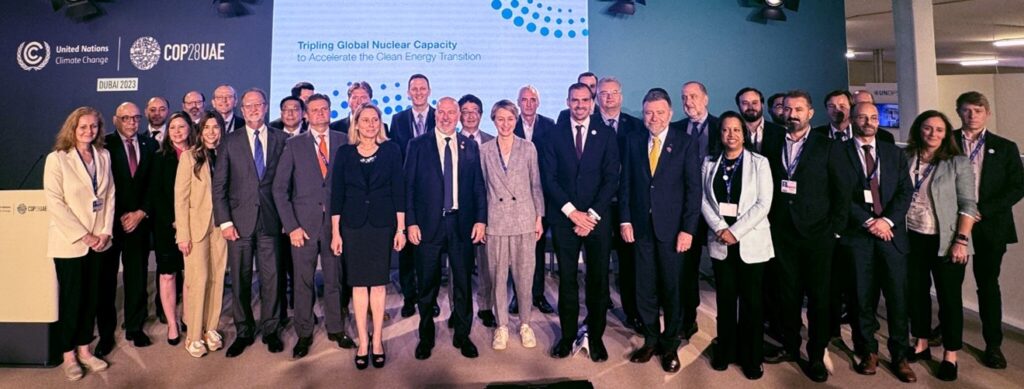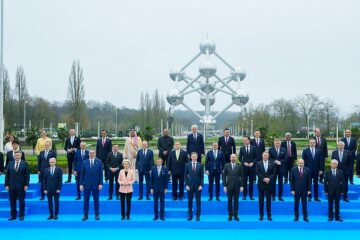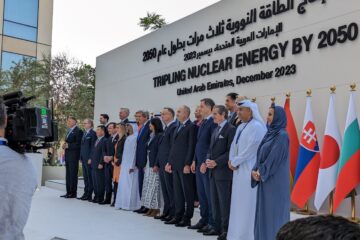Tripling the global nuclear fleet will require massive capacity building
In our last post we looked at the pledge signed by more than 20 countries at COP28 in Dubai to triple the amount of nuclear globally by 2050. This month we consider the pledge made by more than 120 companies in the nuclear industry to meet this challenge and support a tripling of nuclear power by 2050. This is all part of the Net Zero Nuclear initiative started by the WNA (World Nuclear Association) and ENEC (Emirates Nuclear Energy Company) calling for unprecedented collaboration between government and industry leaders to at least triple global nuclear capacity to achieve carbon neutrality by 2050.

Source: WNA photo COP28 December 2023
Tripling the global nuclear capacity is no small feat. Today there are 437 reactors in operation with a combined capacity of about 400 GW. Tripling means adding another 800 GW by 2050. In a combination of large nuclear and new Small Modular Reactors (SMRs), this would mean anywhere from 800 to 2500 or so new units being built around the world. Currently, there are 61 units representing about 68 GW under construction, only 7.6% of the way there. And two thirds of these units under construction are in or exported by China and Russia. In other words, the western nuclear industry has a long way to go to do their part in achieving this lofty goal. The question is then, how can we get there from here and why is this pledge so important?
Some say it is a pipe dream. We say the first step in solving any problem is to clearly define it. In this case, to express an ambition – and that was clearly set out at COP28. Understanding the need, the question then becomes how the industry can scale to meet this demand? This requires a rapid increase in development of both the global supply chain and the human talent needed to deploy at this scale.
This is huge change for the industry. It is (except for China, Russia and possibly Korea) used to being in a global market with few new projects and too many suppliers. On top of that there have been many false starts on a renewal (or renaissance) in the past that did not work out. So, the industry has been reluctant to make the necessary investments to support the capacity building needed.
The first step is to firm up this new demand. This must be driven by government. And it has begun. Already since COP, France has announced its plans to build 14 new EPR2 units by 2050 and the UK has issued its nuclear plan on how it will meet its target of 24 GW by 2050. The UK document is clear in that capacity building and human workforce development is a critical part of this plan. Here in Canada work is underway to look at how to scale to meet 2050 growth projections as well. The US has a lot of work to do to determine how to deliver its ambition of 200 GW of new nuclear by 2050. And yes, where will the resources then come from for projects in Poland, Czechia, Estonia, Slovenia, Bulgaria, Saudi Arabia, South East Asian countries and the many possible nuclear newcomers in the global south?
The nature of global competition will also change. There will be enough work to support multiple vendors, both for traditional large nuclear and SMRs. To be successful, there must be a focus by each vendor on delivering fleets of their designs to be as efficient as possible. This can then support development of global supply chains with sufficient capacity and the human talent needed for delivery. The potential volume of work will encourage productivity improvements resulting in more on time and on budget delivery at lower total cost.
To meet the goals of net zero by 2050 and global energy security, the effort to build industry capacity is required now. All countries interested in new nuclear need to work on developing the people they will need to succeed. The ambition is clear – now is the time to act.





2 Comments
bruce · February 14, 2024 at 6:04 pm
It looks very ambitious considering the build time for Nuclear.
Although I read this morning, a similar forecast of 400 GW of additional Solar, Wind & Hydro (combined) is predicted to be achievable before 2030.(source IEA meeting in Paris). Let’s hope both will meet these objectives.
I always enjoy this blog,
Thx,
Bruce
Nuclear Energy Summit – Broadening the nuclear coalition – mzconsultinginc.com · March 29, 2024 at 10:40 am
[…] at COP28 in Dubai to triple the amount of nuclear globally by 2050 and the pledge made by more than 120 companies in the nuclear industry to meet this challenge. This month we comment on the first global Nuclear […]